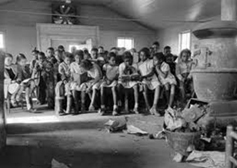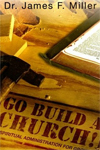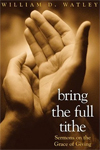|
STEWARDSHIP SUNDAY (TITHING YOUR FINANCES)
CULTURAL RESOURCES
Sunday, September 30, 2012
Imani Jones, Guest Cultural Resource Commentator
Pastor, Shaker Heights Community Church, Shaker Heights, OH
Lection – Luke 16:1-13
I. History
The black church is unequivocally the most service-based and philanthropic organization in the black community.1 Since its inception the principle of giving as a means to meet the needs of the least of these has been central to the identity and overall purpose of the black church. This spirit of giving precedes the formation of the black church in America—it extends back to life in the African village where the essence of life included helping one’s neighbor and caring for those who were unable to care for themselves. Among our African ancestors there was a deep belief that God is concerned about all elements of human life. Believers in this God were called to share in God’s concern for humanity and to respond in kind. Though much of African culture was stripped from our ancestors when they arrived in the Americas, meeting the needs of all remained an integral part of life for blacks in the Americas. The pioneers of the black church understood that consistent financial contributions in the form of tithes, offerings, and dues were essential to effectively impact the quality of black people’s lives.
The principle of tithing has been important to the roots of the black church. Though blacks did not possess much material wealth, they knew and understood the importance and power of pooling their meager resources in order to accomplish God’s purposes for their lives and communities. In addition, the people were wise and creative in how they made their money stretch to meet personal needs while they also consistently gave to the church. Amazingly, during slavery and in the reconstruction era, times of abject poverty and economic scarcity, blacks purchased land and founded and established many churches and operated schools that aided in the economic uplift of the race.2

Black Church in Ohio built in 1850 |
|

One-room church-built school house |
|
Black churches did not have the benefit of outside funding that many white and affluent churches had. As C. Eric Lincoln and Lawrence H. Mamiya rightly note, “…very few black churches have any endowment income to sponsor programs.”3 This reality, however, did not deter them in their financial commitment to the church. All these faithful pioneers had were themselves and their ability to generate financial gain creatively for the survival and overall improvement of the community. Many of these churches built with the nickels and dimes of these pioneers still exist today.
When the earliest black churches were formed in the Americas its members mainly were slaves and later sharecroppers or tenant farmers. They had few resources, certainly much less than most of us possess today. However, they understood their spiritual service and worship to the Lord within the context of giving. They were good stewards of their resources so as not to forsake their responsibility to give. Weekly, bi-weekly, and monthly contributions were and must continue to be given with regularity.4 During the infancy stages of the black church, its members gave from their hearts in faith, believing that God would meet their individual and collective needs.
In order to adequately meet the needs of members of the community—the poor, the disenfranchised, the abused, the orphan, the widow, and all who dwell inside and outside the four walls of the church—financial contributions have always been and continue to be crucial. Many black churches, whether huge edifices or storefronts, have historically been located in areas of great economic distress. Consequently, they are geographically positioned to perceive such needs and to give their tithes and offerings in direct response to those needs. It has been within the context of the church that African Americans have historically taken the principle of giving to facilitate community development and to create health programs, missionary societies, benevolent funds, mutual aid societies, and food pantries. Indeed, none of these entities could have been established and operated without the monetary gifts and donations of those who sit in the pews. Each of these entities and many more continue to be necessary in the church and community. Therefore, continued emphasis on the importance of tithing as the most effective way to operate churches remains critical to improve the lives of all members of the community.
Finally, beyond the practical elements of tithing, it is important to note that tithing for members of the black church is a spiritual act of worship. It is out of one’s relationship with God that anything is rendered unto God, even financial resources. This relationship with God drives the heart of the giver to give. This relationship motivates the giver to give cheerfully, not grudgingly or out of necessity, because God loves a cheerful giver. This relationship empowers the giver to behave as the widow who gave her mite though it was all she had. This relationship operates within the boundaries of trust that God will supply all needs according to God’s riches in glory. This relationship allows the Holy Spirit to lead in the giving process; it moves the giver from the moment the giver purposes within his or her heart to give, to the moment when their dollars or coins are placed in the offering plate. Though giving ten percent is a sacrifice, members of the black church who embrace the principle of tithing have historically done so with a spirit of gratitude for the ability to give and with the conviction that God will bless them to give again.
II. Contemporary Challenges to Tithing
In a time of economic crisis and scarcity in the country and certainly in the black community, tithing may be a very challenging concept for many. Though economic progress has been made since the onset of the economic recession in 2008, the reality is that blacks were struggling financially before the recession and continue to struggle. Those in both the lower and middle classes continue to struggle financially as joblessness and layoffs continue to plague our nation and the black community in particular. It may not seem financially feasible to give ten percent of one’s income to the church when such giving could interfere with making ends meet on the home front.
Another challenge that may impact the act of tithing for many congregants is that of materialism. With the acquisition of material possessions being glorified in all forms of media—music, television, magazines, and even by churches—giving does not hold the same level of importance that it did for our ancestors. The concept of giving for the sake of giving without the expectation of material gain is losing ground in contemporary American society. As consumerism reigns supreme, the principle of tithing can be lost amidst our rush to obtain the latest fashion fads and electronic and vehicular upgrades. When the global economic downturn began in 2008, all economists made clear that Americans were over-consuming on non-essential goods that they could not afford. Credit card and related debt was out of control. This was also true in the black community, but we suffered twice as much for our lack of fiscal responsibility. Being good stewards over financial resources has stiff competition as we continue to see limited financial frugality and economic responsibility even as the recession drags on. By the time Sunday morning arrives and the time for tithing is at hand, for many there may not be much left to render in the aftermath of the acquisition of material possessions.
A third challenge that causes skepticism for some who are considering tithing is the concern about the use of church funds by pastors. While there are many people in the church who tithe their finances with the belief that their contributions will be used appropriately, there are also those who do not possess such confidence. For those who experience the preacher as being much more financially well off than the people he or she serves, tithing can be a major challenge. Also, as prosperity preaching continues to maintain a foothold in the religious landscape of our times, distrust can have a major influence on the decisions of parishioners to give or not to give to the Church as they watch too many ministers who live economically extravagant lives.
III. Strategic Plans for Tithing
The spiritual principle of tithing must be taken very seriously in order for the black church to continue to thrive and function as the cornerstone of caring in the black community. Without the consistent gifts and generosity of the church as a whole, the black community as a whole will fail to thrive and walk in the fullness of freedom, wholeness, and good health which is what God intends. In order to remain consistent and even increase tithing in the black church, there are several strategies that can be adopted:
- Preach a sermon series on tithing over the course of several weeks. Address the biblical mandate of tithing, dispel myths about tithing, and promote the individual and corporate benefits of tithing.
- Use Bible study as a companion to the sermon series to delve deeper into the spiritual meaning and practical need for tithing.
- Expose members to the history of giving by the black church. Use images and music. Show pictures of the schools and benevolent associations that black churches built and operated in the late 1800s through the mid 1900s.
- Launch a major stewardship campaign after you have completed the sermon series and Bible Study on tithing. Make sure that the campaign concerns a great need that the church and/or community has. Perhaps a survey should be done to determine the need. If you do not know how to launch a stewardship campaign, there are good books and websites that will aid you. See the resources listed at the end of this cultural resource unit and at the end of today’s Lectionary Commentary.
You can even do a new campaign each year. One campaign may raise funds to help low-income seniors pay their utility bills. Another could help the church provide backpacks and school supplies for low-income elementary school students. Still another could help raise funds so that your church can work collaboratively with another major organization and contribute financially to stemming a community problem such as gun violence or illiteracy. And of course there are the standard stewardship campaigns that provide for church refurbishment and repair.
- Include brief personal testimonies during the Sunday worship service that highlight the blessings experienced by a tither in the church who gave not expecting anything in return.
- Offer regular slide shows, other visual aids, newsletters, and pastoral emphases on how tithes and offerings are being used in your church. Examples of this could include benevolent donations to families in need, pictures of families being presented with food baskets during the holidays, and pictures of high school and college graduates who received scholarships. Providing people with information on how their contributions are being used will empower some to continue to tithe as well as plant seeds in the hearts of others to begin tithing.
IV. Personal Story about Giving
One of the most profound ways in which I have experienced the power of tithing to advance the work of the Kingdom occurred at the church where my husband and I recently became the pastors. We had been serving as pulpit supply at Shaker Heights Community Church for eight months, preaching every third and fourth Sunday. Though we lived two hours away from the church we were excited to have the opportunity to minister as a husband and wife team. The church had been without a pastor for two years. In addition, there had been several major transitions in pastoral leadership over the past ten years that left the church vulnerable and in a perpetual state of instability. As we shared the Word of God with the people, interacted with them, and grew to care deeply for them our hearts began to ache for this small church that was trying to do its very best to keep on keepin’ on.
Shaker Heights Community Church consists in large majority of senior saints who committed to be faithful and remained at the church even when more than seventy-five percent of the congregation withdrew their membership. Beyond Sunday morning worship there was very little the church could render in terms of programming, outreach, and other forms of ministry. The one thing that they so desperately wanted was a pastor who would lead them, ultimately stay with them, and cast a vision that would restore their former glory. However they were barely staying afloat financially. They could not afford to compensate a pastor to facilitate healing and growth in the church. At the same time, the members of the church had a strong conviction that the only way they would heal and grow was to have strong leadership in the form of a pastor to facilitate healing and growth.
After my husband and I had served as pulpit supply for Shaker Heights for about eight months we were approached by the Church Moderator. She wanted to know if we were looking for a permanent church home and pastoral positions. She shared with us that though they were a small church and had very few resources they were led by God to call not one of us but both of us to serve as the pastors of the church. The members had a heart to serve God and felt that part of their service in this particular season was to bring us on board as pastors. They called a congregational meeting which resulted in each member committing to tithing every Sunday in order to present us with a humble financial package that they believed would grow with time.
Though many of these senior saints have fixed incomes and live in a time of economic scarcity and distress, they collectively made a decision to step out on faith and trust God with their finances in their desire to advance the Kingdom of God. There are far larger churches with greater resources who would not consider the very real financial strain of hiring more than one pastor. Indeed, there is wisdom in such a decision, and all churches should evaluate their financial obligations carefully as well as be prayerfully discerning about how God is leading them. In the case of Shaker Heights Community Church, the membership moved in the direction that God was leading them through tithing their finances. Since my husband and I became pastors of Shaker Heights less than a year ago, God has been working and moving in powerful ways. We can all clearly see that through this small church with a big vision and a heart for God, indeed the Kingdom of God is advancing in ways that continue to astound and amaze us each and every day.
V. Songs
The legendary Shirley Caesar sings very directly about the importance of giving tithes and offerings. We will be blessed as a result of giving to the poor. Indeed, God will open the windows of heaven and bless us as a result of our obedience and sacrifice.
Tithes and Offerings
by Shirley Ceasar
If you want to be blessed,
Pay your tithes and your offerings
If you want more,
give it to the poor (repeat)
And the Lord will give it back to you (2x)
He said He’d open up the windows of Heaven,
Pour you out a blessing:
He will supply you every need
according to his riches in glory
Give and you shall receive (2x)
If you want to be blessed (repeat)
Give and you shall receive 5
Encouraging believers to give from their hearts is a very important element of giving. While the temptation may be to prompt people to give in order to receive God’s blessings, Ron Kenoly’s “Give to the Lord” does not place its focus there. Instead, the song focuses on the inner love, joy, and gratitude that can create a desire within to give.
Give to the Lord
by Ron Kenoly
Chorus:
Give and it will
Come back to you
Good measure pressed down
Shaken together and
Running over
Give and it will
Come back to you
When you give
Give to the Lord
Verse 1:
Give in love
Give in faith
Give the joy and the
Smile on your face
Give as the Lord
Has given to you
How you give is a
Reflection of your gratitude
Verse 2:
From your heart
Give your best
Give unto God
And you will be blessed
Don’t be stingy
And don’t be tight
Learn from the widow
In the Bible
Who gave her last dime
Verse 3:
People rob God when they
Don’t give tithes and offerings
And they don’t understand why
They’ve been cut off
From heavenly blessings
But abundant life and prosperity
Begins when you prove
Your love to God by
Giving to Him
When you give
Give to the Lord6
Giving cheerfully is so important when it comes to tithing and offering. The biblical mandate is clear: we are not to give grudgingly or out of obligation, but because we want to give. Joe Pace’s “Running Over” is an upbeat song full of energy and meaning that can tap into the giving spirit of all. There are blessings that will undoubtedly run over in the life of all who freely give.
Running Over
by Joe Pace
Pressed down shaken together; running over, running over (4x)
When you give unto the Lord
He will give you more
So cheerfully now bring your offering
And you’ll have blessings running over, running over
Blessings running over, running over
Pressed down shaken together; running over, running over (2x)
When you give unto the Lord
He will give you more
So cheerfully now bring your offering
And you’ll have blessings running over, running over
Blessings running over, running over
When you give unto the Lord
He will give you more
So cheerfully now bring your offering unto the Lord!
The windows of heaven will open unto you
running over, blessings running over.
So many blessings you want have any room
running over, blessings running over (repeat)
When you give unto the Lord
He will give you more
So cheerfully now bring your offering unto the Lord!
The windows of heaven will open unto you
running over, blessings running over.
So many blessings you want have any room
running over,
Blessings running over (repeat)7
VI. Books and Other Resources
 |
Johnson, Derek E. You Always Have Options: Guiding Principles for Managing Money. Atlanta, GA: Unique Publishers, 2006.
|
 |
Miller, James F. Go Build a Church: Spiritual Administration for Growth. Enumclaw, WA: WinePress Publishing, 2007.
|
 |
Ross, Charles. God’s Plan for Your Financial Success. Nashville, TN: Nelson, 1998.
|
 |
Watley, William D. 10 Steps to Financial Freedom. Newark, NJ: New Seasons Press, 2007.
|
 |
Watley, William D. Bring the Full Tithe: Sermons on the Grace of Giving. Valley Forge, PA: Judson Press, 1995.
|
 |
Paarlberg, Laurie E. “Managing in Lean Times.” Jewish Federations.Org. Online location: http://www.jewishfederations.org/
local_includes/ujcfiles/ga09/program/spkrdownloads/(F08)
%20Successful%20Management%20in%20Lean%20Times%20-%20Powerpoint2.PDF. This site contains the discussion paper by Laurie E. Paarlberg, a professor in the public administration program of the University of North Carolina Wilmington, entitled “Nonprofits and the Economic Recession.” |
Notes
1. Byrd, Alicia D. Philanthropy and the Black Church. Washington: Council on Foundations, Inc., 1990. p. xi.
2. Lincoln, C. Eric and Lawrence H. Mamiya. The Black Church in the African American Experience. Durham: Duke University Press, 1990. p. 244.
3. Ibid., p. 254.
4. Floyd Massey Jr. and Samuel Berry McKinney, Church Administration in the Black Perspective. Valley Forge: Judson Press, 2003. p. 108.
5. Caesar, Shirley. “Tithes and Offerings.” …He Will Come. New York, NY: Sony, 1995.
6. Kenoly, Ron. “Give to the Lord.” High Places: The Best of Ron Kenoly. New York, NY: Sony, 1997.
7. Pace, Joe. “Running Over.” Joe Pace Presents: Sunday Morning Service. New York, NY: Sony, 2004.
| 
